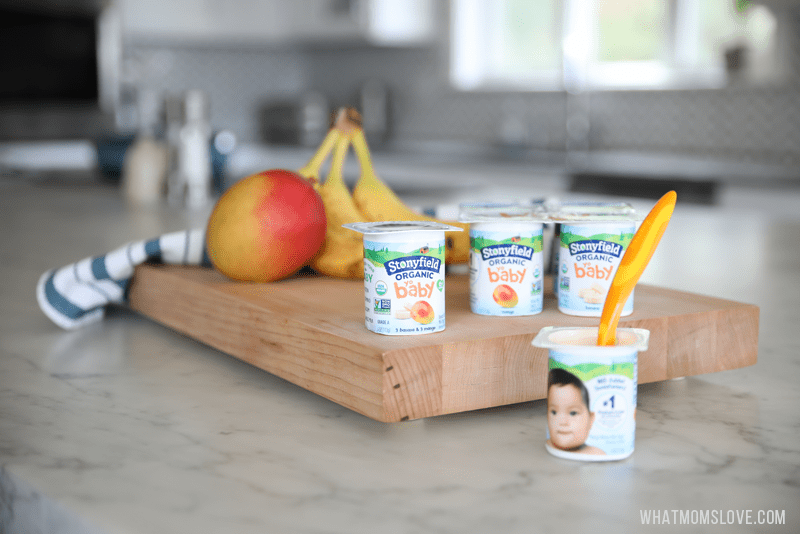Wondering what are the best first foods to feed your baby? We’ve created a free printable checklist with foods and flavors to try + helpful tips for starting solids.
Many parents starting their babies on solid food will wonder, “what is the absolute best first food I can feed my baby?”, looking for a concrete answer like “peas” or “carrots”. However, the exact first food is fairly insignificant – instead, it’s the variety of healthy foods you serve your baby in their first few months of eating solids that’s most important.
Studies have shown that trying a wide assortment of flavors with your infant can keep picky eating at bay, and will ultimately make them more willing to try (and accept!) other new foods in the future. Plus, these are the foods that are helping fuel your baby’s development and growth, so the more they can enjoy a variety of nutrient-rich foods, the better.
With this in mind, we’ve team up with our sponsor, Stonyfield Farm, to create a free printable chart that is loaded with ideas of nutritious foods and flavors to try with your baby – allowing you to track your attempts and their reaction.
So whether your baby is just starting on purées, moving onto solids, or doing Baby-Led Feeding, you’ll be able to make sure they’re getting a wide variety of healthy foods, and expanding their palette in the process.
Read on to learn how to download the printable and get our helpful tips for starting solids.
PIN for when you’re ready to start solids!

PRINTABLE TRACKING CHART

So here it is! Our free Printable Tracking Chart for Baby’s First Foods.
You’ll see that it’s full of suggestions for nutritious foods to serve your child – from fruits and veggies, to grains, dairy and proteins. There’s even suggestions for different spices and flavors to incorporate to further expand their horizons.
And if there’s a certain food or dish you’d like them to try that’s not listed, simply add it in the “Other Foods” section that we’ve left blank.

Each food has 5 “check boxes” next to it, so as your serve it to your baby, you can check off one of the boxes. You can even make the circle into an emoji based on your child’s reaction. As it can take 5-10 tries for a baby to decide whether or not they like a certain food, this will help you track your attempts and serve as a reminder to be patient and keep trying!
To download our printable Baby’s First Foods Tracking Chart simply enter your email into the box below and we’ll immediately send you the PDF right to your inbox:
Whatever foods you decide to try first, keep these tips in mind:
The Waiting Game: Many pediatricians recommend waiting 3-5 days between trying each new food so if your baby develops any reaction, it will be easier to pinpoint the culprit. Others will waive this waiting period except with higher-risk foods like peanut butter or eggs. Discuss with your child’s Doctor the length of time their practice recommends waiting.
No Raw Honey: Avoid feeding you infant raw honey until they are at least a year old, as there is a risk of infant botulism, a deadly disease.
Avoid Cow’s Milk Until 1 Year: Babies can’t digest straight-up cow’s milk as well as they can breast milk or formula, and the high concentration of protein and minerals can cause stress to their developing kidneys. Doctors only recommend starting cow’s milk once your baby is a year old.

Yogurt is A-Okay! Because cow’s milk is off-limits for the first year, many parents think this means yogurt is a no-no. But that’s actually not the case! Pediatricians give yogurt the thumbs up for babies beginning at six months. Yogurt has live, active cultures that break down the lactose and protein, so it’s much easier for babies to digest. Some, like our recommended Stonyfield YoBaby yogurt, include added Vitamin D and the probiotic BB-12 which supports a healthy gut microbiome and aid in digestion. It’s also made with whole milk which is important as fat is critical for brain development. And like all of Stonyfield’s yogurts, YoBaby is organic which means it includes no harmful persistent pesticides, antibiotics, artificial growth hormones, or GMOs.
Don’t Undercook: Make sure everything you feed your baby is well cooked, especially meats, eggs and shellfish, as their bodies are more sensitive to bacteria and can therefore be at a higher risk of getting food poisoning.
Fish: Avoid fish with high levels of mercury like Swordfish and Marlin.
Keep Food Unsalted: Don’t add salt to any homemade food, and keep your eye on sodium levels of anything store-bought. The guidelines for a child under 1 is to have less than 1g of salt (0.4g sodium) a day.

Avoid Artificial Sweeteners: Babies don’t need artificial sugars, especially when you can use natural sweeteners like mashed or puréed fruits and veggies to sweeten more “bland” foods. But babies really don’t know any different – try them with one of Stonyfield’s YoBaby yogurts with no added sugar, like their Plain, Banana Mango or Veggie flavors, and you’ll see that they will quickly gobble it up!
Make Your Meat Tender: Make proteins like beef, chicken or pork easy to chew by tenderizing them in a slow cooker or InstaPot.
Steam or Roast Veggies: Soften your vegetables by steaming or roasting them. Purée if you are spoon feeding or keep them in long sticks for Baby-Led Feeding.
Cook With Broth: Cook any grains or vegetables in an unsalted bone broth instead of water. It not only adds additional nutrients, but exposes them to other flavors.
Allergens: It is no longer recommended to delay the introduction to potential allergens like peanut butter and eggs. In fact, studies have shown that the early introduction of allergenic foods around 6 months of age could potentially decrease their risk of developing a food allergy. Discuss your strategy with your child’s pediatrician, especially if you have a family history of food allergies.
Spice Things Up: Don’t be afraid to try different spices and seasonings with your baby. Sprinkle some cinnamon on apples, a squeeze of lemon on chicken or rosemary on potatoes. The more combinations they are exposed to, the more they will accept new foods in the future.
RELATED: 18 Tips to Raise an Adventurous, Non-Picky Eater From Baby to Toddler & Beyond
Try Different Cooking Methods: A food’s taste can be completely transformed depending on how you cook it – the difference between a boiled Brussel Sprout and a roasted one is like night and day. So mix it up! Once your baby has tried a food one way, use a different method the next time. Grill, roast, boil, steam, slow cook, sauté – expand your cooking repertoire and their palette at the same time!
First Aid: Always be present while your baby is eating. Know the difference between choking and gagging, and what to do in either case.

To download our printable Baby’s First Foods Tracking Chart simply enter your email into the box below and we’ll immediately send you the PDF right to your inbox:
Whatever you decide to try first, make sure it is a healthy, nutrient-rich choice. Bon appetit!
Thanks again to our sponsor, Stonyfield Farm, for making the #1 Pediatrician recommend yogurt – a perfect first food for 6+ months.
Looking for a great starter recipe for your baby’s breakfast that you and your family can also enjoy? Try our healthy Blueberry Oatmeal Pancakes – they have no added sugars, and are fluffy and delicious!


















Little Nadav is 7 months and has just started eating biiiig portions of food!! I can’t believe how much he can eat. I do think its true that introducing foods like peanut butter(nada tried Israeli “bamba” today for the first time”, earlier on is better for them. The rate of children with peanut allergies in Israel is significantly lower than in America because of the MAJOR snack food for kids- bamba, which is like Cheetos but with peanut butter.
http://soulandstreusel.com
I can’t find where to be able to download the PDF check list. Please advise
There is a box to enter your email and then it is sent right to you. If you can’t find it, email us directly at info@whatmomslove.com and we will help!
Thank you so much for providing this printable! It’s the best free version by far, and better than some of the paid versions I almost bought from Etsy. I’m a grateful mama!
You’re so welcome – that makes us so happy!
Please email us at info@whatmomslove.com and we’ll send it directly to you!
Thank you so much! I love all the options and it looks so good!
Thanks for the free guide ! First time mom here with no clue and I really like that you explained about trying foods 1 for a few days makes total sense to see if any allergies